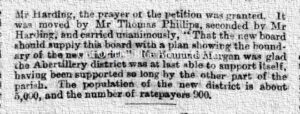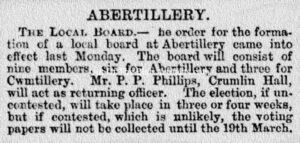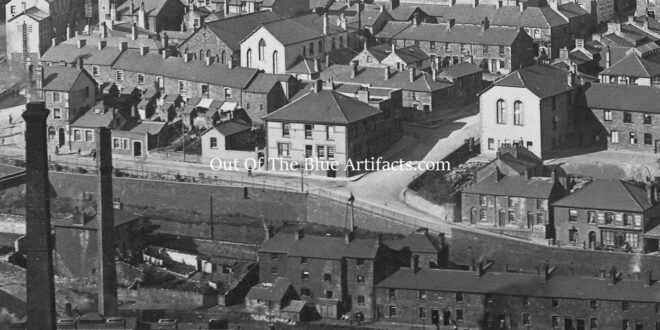Abertillery Council Authorities.
The Old Aberystruth Rural Sanitary Authority.
Abertillery was originally under the jurisdiction of the old Aberystruth Rural Sanitary Authority based at Blaina. The chairmen of the authority in the 1870’s were Mr Spencer and Mr James Phillips. Other members of the board were as follows – Mr Edmund Morgan; Mr Thomas Phillips; Mr J. R. Harding; Mr J. Green; Mr W. Graham; Mr R. Morris; Mr Thomas Thomas; Mr C. Rice-Harris (Clerk) and Mr James Allen (Overseer). At this time Mr Williams, surgeon of Abertillery was (Medical Officer) with a salary of £40 per year. Mr Collins was (Inspector of Nuisances) with a salary of £80 per year. The inspectors district within the Aberystruth Rural Sanitary Authority extended from Nantyglo, through Blaina, Abertillery, Aberbeeg, Cwm, New Town (Ebbw Vale), Blackwood, Argoed, Pengam, Bargoed to New Tredegar.
 On Thursday 27th of January 1876, a special meeting of the Aberystruth Rural Sanitary Authority was held at the Castle Hotel, Blaina. The chairman of the authority was Mr James Phillips. Other members of the board were as follows – Mr Edmund Morgan; Mr Thomas Phillips; Mr J. R. Harding; Mr J. Green; Mr W. Graham; Mr R. Morris; Mr Thomas Thomas; Mr C. Rice-Harris (Clerk) and Mr James Allen the overseer. The meeting was held to discuss the application of the Abertillery District to form a local board. A letter was read from the Local Government Board acknowledging the receipt of a petition from the inhabitants of Abertillery for a local board. The population of the new district was 5,000 with 900 of those being ratepayers. The motion was carried and the new board was told to give the old board plans showing the boundary of the new district.
On Thursday 27th of January 1876, a special meeting of the Aberystruth Rural Sanitary Authority was held at the Castle Hotel, Blaina. The chairman of the authority was Mr James Phillips. Other members of the board were as follows – Mr Edmund Morgan; Mr Thomas Phillips; Mr J. R. Harding; Mr J. Green; Mr W. Graham; Mr R. Morris; Mr Thomas Thomas; Mr C. Rice-Harris (Clerk) and Mr James Allen the overseer. The meeting was held to discuss the application of the Abertillery District to form a local board. A letter was read from the Local Government Board acknowledging the receipt of a petition from the inhabitants of Abertillery for a local board. The population of the new district was 5,000 with 900 of those being ratepayers. The motion was carried and the new board was told to give the old board plans showing the boundary of the new district.
The Formation of the Abertillery Local Board.
In December 1876 the Abertillery Local Board was established, the new board took control of the Abertillery district from the old Rural Sanitary Authority. The first six Abertillery Local Board officers were elected as follows – Mr Lewis Richards; Mr Titus Phillips; Mr J. Green; Mr P. A. Williams; Mr Basil Jayne; Mr E. Walker for the Abertillery Ward: Mr Joseph Wallace; Mr J. A. Harding and Mr S. Jones for Cwmtillery Ward:
The Abertillery Local Board’s First Offices. (Amended).
It has recently come to my attention that the first offices that were used by the Abertillery Local Board was situated at No.6 High Street, Abertillery. Newspapers published in the late 1870’s announced that all correspondence in relation to council matters and plans for viewing to be seen at, or were to be addressed to No.6 High Street, Abertillery. Sadly, as house numbers and addresses, since 1876-1885 have been altered, new buildings have been constructed and old ones have been demolished, as in the case of High Street with the later Arcade and surrounding buildings rebuilding scheme including St Michaels Cottages etc in the late 1890’s, there is no way of identifying where these first offices were unless there is some sort of detailed town map available from that time.
 The First Elected Members of the New Abertillery Local Board 1877.
The First Elected Members of the New Abertillery Local Board 1877.
On Monday 26th of February 1877, the first nomination of the members of the Abertillery Local Board took place. The following names were handed to Mr Phillip S. Phillips, returning officer owner of the Abertillery Tin Plate Works, Abertillery Ward – Mr P. A. Williams (Colliery proprietor of the company Clapp & Williams); Mr Basil Jayne (Colliery Proprietor) of Panty Bailey; Mr J. Green (Abertillery Tin Works Manager); Mr William Webb (Wine and Spirit Merchant) of Aberbeeg; Mr L. Richards (Grocer and Draper) of Abertillery; Mr Titus Phillips of Abertillery; Mr Arthur Tilney (Clerk) of Abertillery Tin Works; Mr Alex James (Property Owner) of Abertillery; Mr Richard Middleton (Contractor); Mr E. Walker (Outfitter): Cwmtillery Ward – Mr John Jones (Manager South Wales Colliery); Mr J. Harding (Cashier); Mr Joseph Wallace (Property Owner, Colliery Manager) of Cwmtillery; Mr S. N. Jones (Grocer and Draper) and Mr Thomas Robins of Abertillery:
A meeting was held to discuss the results (More information to come).
The district under the jurisdiction of the Abertillery Local Board covered the following area – From Aberbeeg up the Cwm Valley to Llandafal Village and the Waterloo Inn, up over the Arael Mountain into Rose Heyworth Colliery, up to Blaentillery Farm, Cwmtillery due east to the Parish of Blaenavon, along the imaginary line dividing the Parish of Aberystruth from the Parish of Abersychan, Pontnewynydd and Llanhilleth. The district contained a population of 6,000 and was divided into two wards, the Abertillery Ward and the Cwmtillery Ward.
The Local Board Offices at King Street, Abertillery.
The Abertillery Local Board Offices (as seen above in the main featured image) were situated on the junction of King Street and Railway Parade (later renamed Castle Street).
The Formation of the Abertillery Urban District Council.
In May 1894 the Abertillery Local Board became the Abertillery District Council under the Local Government Act of 1894. At the change over the members of the council were as follows – *Mr Edward Jones (Chairman); Mr J. E. Webb; Mr J. Handy; Mr Joseph Wallace; Mr James Jones; Mr T. Robins; Mr J. T. Williams; Mr D. Lewis and Mr H. J. Baker:
Mr Edward Jones was appointed chairman taking over from the late chairman Mr Lewis Reynold Rogers of Rogers Buildings, Cwm Street, Abertillery. Mr Edward Jones was chairman only until the forthcoming elections took place. Mr Lewis Reynold Rogers had sadly passed away the previous month, after falling ill while in Cwmtillery inspecting the site for the proposed reservoir. Mr Titus Phillips was appointed Vice Chairman. It was suggested that the district be divided into four wards, Cwmtillery Ward, Abertillery Ward, Penybont Ward and Llanhilleth Ward. Mr William Stewart (Mining Engineer and General Manager of the Powell’s Tillery Collieries) of Gelli Crug was appointed to the council. *Mr Edward Jones was chairman only until the forthcoming elections took place.
Abertillery Urban District Council Elections 1894.
In December 1894 the first elections in connection with the Abertillery Urban District Council was held. The candidates were as follows, those marked* were members of the old local board –
Abertillery Ward – Mr George Caleb Dancey, (Coal Miner); Mr George Gregory, (Furniture Dealer and Ironmonger); Mr William Jordan, (Boot Manufacturer); Mr William Rees, (Manager) an invalid nomination and *Mr John Edgar Webb, (Solicitor):
Cwmtillery Ward – Mr William Charles Cowdrey, (Coal Miner); Mr Sidney Dando, (Coal Miner); *Mr Daniel Lewis, (Colliery Manager); Mr Paul Love, (Draper) an invalid nomination; *Mr Joseph Wallace, (Gentleman) and *Mr John Thomas Williams, (Manager):
Penybont Ward – Mr Thomas Allen, (Insurance Agent); Mr John Thomas Baker, (School Master); Mr James Gunter, (Insurance Agent); Mr Frank Padfield, (Coal Miner); *Mr Titus Phillips, (Postmaster) and *Mr William Stewart, (Mining Engineer):
Llanhilleth Ward – Mr William Thomas, (Grocer); Mr William Davies Davies, (Colliery Manager); Mr William Evans, (Monumental Mason) and Mr J. R. Webb, (Brewer) an invalid nomination;
The results were as follows –
Abertillery Ward – Messrs Webb, Dancey and Gregory, elected.
Penybont Ward – Messrs Baker, Padfield and Stewart, elected.
Cwmtillery Ward – Messrs Lewis, Wallace and Williams, elected.
No results of the Llanhilleth elections.
The First Meeting of the New Abertillery Urban District Council.
On Thursday 3rd of January 1895, the first meeting of the newly elected Abertillery Urban District Council took place at the Council Offices, Abertillery. Those present were as follows – Mr J. E. Webb; Mr W. Thomas; Mr D. Lewis; Mr W. Davies; Mr William Stewart; Mr G. C. Dancey; Mr W. Evans; Mr Frank Padfield; Mr G. Gregory; Mr J. T. Baker; Mr J. T. Williams; Mr Joseph Wallace and Mr J. A. Shepard: Mr Joseph Wallace was appointed (Chairman) and Mr J. T. Williams (Vice Chairman), Dr Williams (Medical Officer) and Mr James McBean (Surveyor) of the Abertillery Urban District Council.
Points of Interest – Mr Edward Jones. Mr Edward Jones was born in Talybont, Breconshire on the 4th of December 1836, he attended Abergavenny Grammar School, went on to become a mining pupil at Beaufort and became associated with Mr Crawshay Bailey. His first official appointment was on the management of the Varteg Colliery under Mr Crawshay Bailey. He later became known to Mr W. B. Partridge and a partnership was formed to take over the proprietorship of the Varteg Collieries and Iron Works.
Mr William B. Partridge was Crawshay Bailey’s great nephew and was living at Llanfoist House, he later left to live in Bacton Hereford but maintained a close partnership with Mr Edward Jones. This partnership worked well as Partridge Jones & Co who later owned the Llanhilleth Collieries.
 Out Of The Blue Artifacts A Library of a lifetime of collecting
Out Of The Blue Artifacts A Library of a lifetime of collecting
